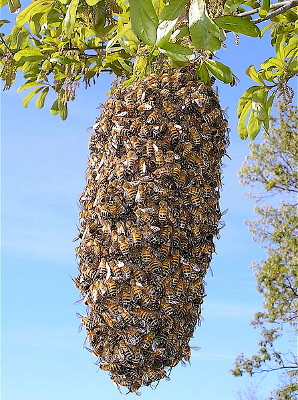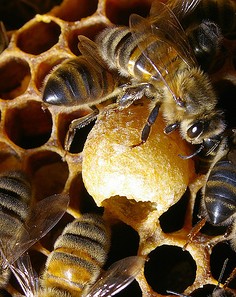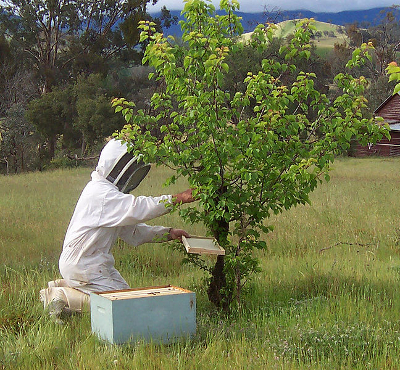
Swarming behavior and prevention
 In nature, a healthy, mature
hive tries to swarm at least once every year. As soon as the
first flowers open, the bees scurry to gather nectar and pollen, which
tempts the queen to lay a lot of eggs and to hatch out plenty more
workers. At a certain point, the hive is getting crowded, and the
bees start filling up the brood nest (where eggs are usually laid) with
honey and pollen. These two conditions --- lots of bees in a
small space and a brood nest full of food --- change something in the
hive mentality, and they decide it's time to make some new queens.
In nature, a healthy, mature
hive tries to swarm at least once every year. As soon as the
first flowers open, the bees scurry to gather nectar and pollen, which
tempts the queen to lay a lot of eggs and to hatch out plenty more
workers. At a certain point, the hive is getting crowded, and the
bees start filling up the brood nest (where eggs are usually laid) with
honey and pollen. These two conditions --- lots of bees in a
small space and a brood nest full of food --- change something in the
hive mentality, and they decide it's time to make some new queens.
Once queen larvae are
developing in the hive, the old queen knows it's time to move on.
She gathers up about 60% of her workers and flies away to another nest
site, leaving the rest of the workers behind to care for the developing
queens. Eventually, the new queens hatch, and one usually kills
off the others before settling in as a new matriarch of the old hive.
From the perspective of
a bee, swarming is an effective method of reproduction. In
addition, the gap in brood rearing between when the old queen leaves
and when the new queen starts to lay tends to break many disease cycles
in the old hive. However, beekeepers generally want to prevent
swarming since a hive that swarms rarely produces much honey.
 Swarm prevention begins with
keeping the brood nest from becoming congested during the first nectar
flow. Michael Bush adds supers as necessary so the bees have
plenty of room to dehydrate nectar. However, supering alone is
not enough, so he also opens up the brood chamber by putting one empty
frame after every two frames of brood. A different beekeeper,
Walt Wright, uses a less invasive method called checkerboarding, which
consists of alternating frames of capped honey with drawn (but empty)
frames in the box above the brood nest.
Swarm prevention begins with
keeping the brood nest from becoming congested during the first nectar
flow. Michael Bush adds supers as necessary so the bees have
plenty of room to dehydrate nectar. However, supering alone is
not enough, so he also opens up the brood chamber by putting one empty
frame after every two frames of brood. A different beekeeper,
Walt Wright, uses a less invasive method called checkerboarding, which
consists of alternating frames of capped honey with drawn (but empty)
frames in the box above the brood nest.
If you didn't get around
to managing the hive and you see queen cups already built, you'll have
to move on to the second phase of swarm prevention. No, don't cut
out those queen cups --- once the bees have decided to swarm, they'll
just build them again. Instead, take each frame with a queen cup
on it and start a "nuc" --- a small, new hive --- with an extra frame
of honey to tide the bees over. More tomorrow on how to handle
nucs, but for now just understand that each of these little hives can
be raised into a new hive to expand your apiary. As long as you
open up the brood  nest at the same time you
create the nucs, the bees should think they've already swarmed and will
get back to work making honey for your larder.
nest at the same time you
create the nucs, the bees should think they've already swarmed and will
get back to work making honey for your larder.
The flip side of the
swarming coin is that the behavior creates an opportunity for
beekeepers to get started with no outlay of cash. This spring, I
may follow Bush's advice and ask police and rescue dispatchers and the
local extension agent to contact me when they hear about swarms.
More on how to catch a swarm when I've put some of my readings into
practice.
| This post is part of our The Practical Beekeeper lunchtime series.
Read all of the entries: |
Want more in-depth information? Browse through our books.
Or explore more posts by date or by subject.
About us: Anna Hess and Mark Hamilton spent over a decade living self-sufficiently in the mountains of Virginia before moving north to start over from scratch in the foothills of Ohio. They've experimented with permaculture, no-till gardening, trailersteading, home-based microbusinesses and much more, writing about their adventures in both blogs and books.
Want to be notified when new comments are posted on this page? Click on the RSS button after you add a comment to subscribe to the comment feed, or simply check the box beside "email replies to me" while writing your comment.
